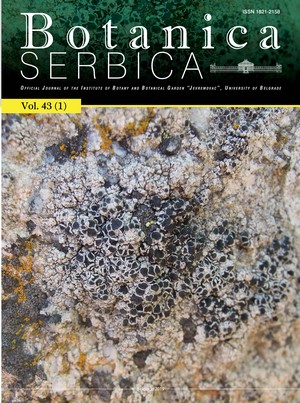
Volume 43 Issue 1 2019 |
Records of lichenicolous fungi new for Turkey and Asia
|
KEY WORDS: Ascomycota, Bingol, biodiversity, lichenicolous fungi, Tunceli |
Bryophyte extracts suppress growth of the plant pathogenic fungus Botrytis cinerea
|
KEY WORDS: grey mould disease, biofungicide, mosses, liverwort |
Karyological and morphological variation within Petrosimonia brachiata Bunge in Bulgaria
|
KEY WORDS: Amaranthaceae, karyotype, chromosome number, morphology, chorology |
Petasites kablikianus (Asteraceae) in the Slovak Carpathians: distribution, chromosome number and genome size
|
KEY WORDS: Petasites kablikianus, nuclear DNA content, karyology, chorology, Slovakia |
Fatty acids of oil and antioxidant capacity of phenolics from fruits of 11 Cardueae (Carduoideae, Asteraceae) taxa from northeast Anatolia (Turkey)
|
KEY WORDS: chemotaxonomy, cypsela, Arctium, Cardueae, Carthamus, Cirsium, Echinops |
Evaluation of bioactivities and phenolic composition of extracts of Salvia officinalis L. (Lamiaceae) collected in Montenegro
|
KEY WORDS: sage, phenolics, antioxidant activity, antineurodegenerative activity, cytotoxic activity |
Cold stress in soybean (Glycine max L.) roots: exogenous gallic acid promotes water status and increases antioxidant activities
|
KEY WORDS: Antioxidant system, cold stress, gallic acid, Glycine max, reactive oxygen species |
Heavy metal tolerance of Pontechium maculatum (Boraginaceae) from several ultramafic localities in Serbia
|
KEY WORDS: Boraginaceae, Echium russicum, trace metal, Balkan Peninsula |
Bioaccumulation of heavy metals in common reed (Phragmites australis) growing spontaneously on highly contaminated mine tailing ponds in Serbia and potential use of this species in phytoremediation
|
KEY WORDS: toxic metals, common reed, phytostabilisation, rhizofiltration |
Rediscovery of Chara canescens Loiseleur in Serbia
|
KEY WORDS: charophyte, parthenogenesis, Kikinda, Plava Banja pond |
Notes on Bolboschoenus planiculmis, a species new to the flora of Bosnia and Herzegovina
|
KEY WORDS: Bolboschoenus, Balkan Peninsula, Cyperaceae, distribution, taxonomy |
Crepis setosa subsp. topaliana (Asteraceae): a new record for the flora of Turkey
|
KEY WORDS: Crepis, endemic, new record, taxonomy, Turkey |
Pleurospermum austriacum (L.) Hoffm. (Apiaceae), a new species in the flora of the Republic of Macedonia
|
KEY WORDS: Pleurospermum, first report, native species, Šar Mountains, Balkan Peninsula |
In memoriam: Prof. Dr. Radiša Jancic (1951 – 2018)
|
List of reviewers for Botanica Serbica in 2018 — Acknowledgements
|


